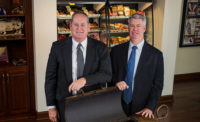It was a tight race to the final day, but after the clock ticked to Aug. 1, 2017, and voting ended, Smithfield Foods’ hometown plant — the Smithfield, Va., processing facility — stood as the winner of The National Provisioner’s 2017 Plant of the Year award.
The eight-plant field of nominees included a wide variety of processors this year, and some big names among all processing facilities visited for cover stories from June 2016 through May 2017. We thank all the nominees for access to their facilities, which allows us to stick closely to our mission to give our readers that unmatched, first-hand look into the operations of some of the most innovative and progressive processors in the business.
Smithfield Foods appeared on the cover of our February 2017 issue in a profile that highlighted the impressive emphasis on innovation throughout the company, riding on the heels of the “One Smithfield” initiative that brought all facets of the company together, aiming toward one goal. The National Provisioner visited Smithfield’s headquarters, innovation center and the Smithfield, Va., plant to witness this innovation in action.
In conjunction with the Plant of the Year award, Andy Hanacek, editor-in-chief, checked in with Smithfield Foods for an update as to what has changed at the plant and beyond since his last visit. Keira Lombardo, senior vice president of Corporate Affairs, offered her comments below:
Hanacek: In the last eight months, since I visited the Smithfield, Va., plant, has the facility made any significant improvements or expansions worth mentioning? Has the plant completed any strategic innovations that have helped improve operational efficiency?
Keira Lombardo, senior vice president of Corporate Affairs: One new development since your visit is that we recently launched a companywide program called Raise Your Hand, an initiative that engages employees by encouraging them to identify and implement ideas on how to improve food safety and/or quality at their facility. Employees are empowered to immediately report any concerns to ensure we are upholding the highest standards of food safety and quality.
We’ve also been continuing to invest heavily in our bacon operations at this facility, with over 100 hours of training for our maintenance and operations teams in the past eight months.
The facility has also been equipped with many upgrades and renovations to include new innovative packaging machinery and a new test kitchen for product evaluations, among other improvements.
Hanacek: While at the plant, I got a first-hand explanation of the blade-stop technology Smithfield uses to keep its employees safe. What is the latest regarding that technology? Has it been expanded or improved since my visit?
Lombardo: Our innovative and impactful blade-stop technology has not changed. We continue to install this technology across our facilities to support and improve worker safety.
Hanacek: We discussed the sharing of innovation throughout the company during my visit — has the Smithfield facility originated any innovative ideas that have been taken successfully to other company plants?
Lombardo: Recently, employees designed, built, and installed a new piece of equipment on our production floor. This innovative design has resulted in substantial cost savings, and also improved yields. We are currently researching installing this technology at our other facilities as well.
Hanacek: How has the company responded to the transition from a traditional meat-processing company to a consumer-packaged-goods business at this point?
Lombardo: We continue to see significant growth across key products and brands solidifying our vision to further transform Smithfield Foods into a world-class consumer packaged goods and protein company.
Hanacek: Beyond the Smithfield facility, what one or two employee-driven innovations have really taken off at the company in 2017 thus far?
Lombardo: Last year, we developed Smithfield Agronomics after we were challenged by one of our retailers to improve fertilizer use in the company’s corn supply chain. We partnered with Environmental Defense Fund to create mutually beneficial relationships with local farmers to improve the flow of agronomic information, increase technology for fertilizer optimization, and expand yields and soil health.
This innovation expanded to support our companywide commitment to reduce our greenhouse gas emissions 25 percent by 2025 across our entire supply chain, from feed grain to packaged bacon. NP
PAST PLANT OF THE YEAR WINNERS
2016: Butterball LLC – Raeford, N.C.
2015: Rastelli Foods, Swedesboro, N.J.
2014: Case Farms — Goldsboro, N.C.
2013: JBS USA — Grand Island, Neb.
2012: Universal Pasteurization Co. — Lincoln, Neb.





Report Abusive Comment